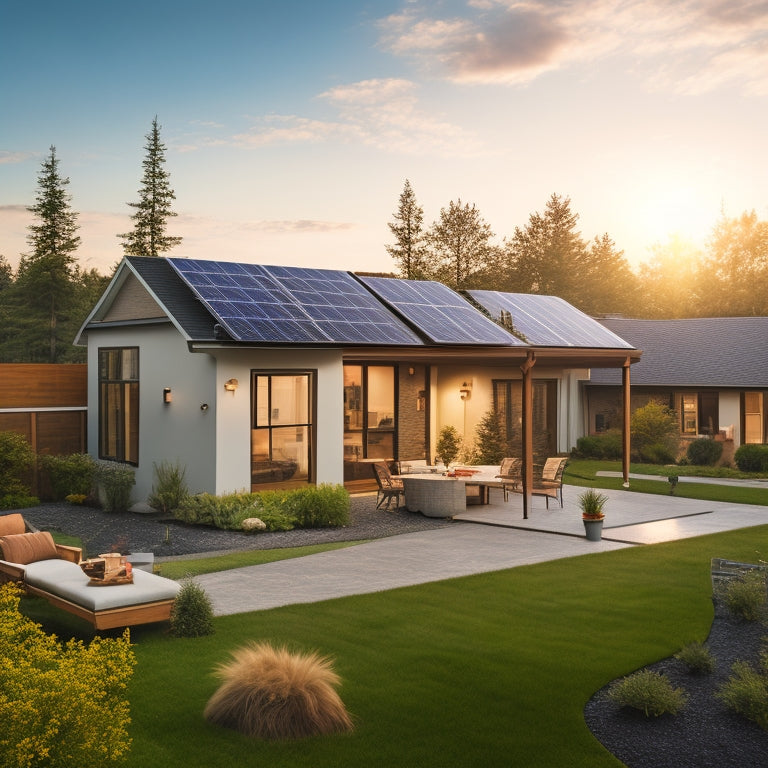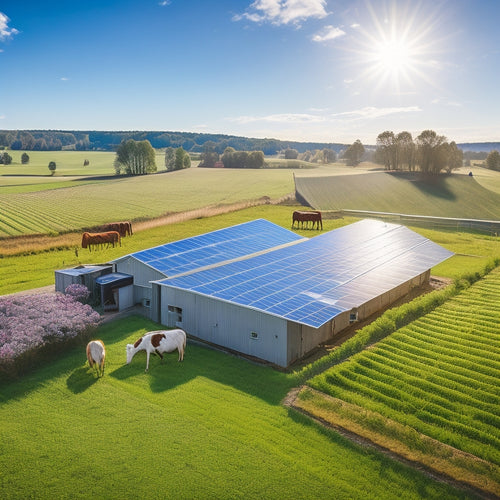
Setting Up a Home Renewable Energy System
Share
When setting up a home renewable energy system, you'll first need to assess your energy needs by reviewing past utility bills and identifying high-energy-consuming appliances. Next, choose the right solar panels based on efficiency, durability, and warranty. Select a compatible inverter that matches your solar panel array's voltage and current output. Properly size your battery bank by considering chemistry, discharge rate, and depth of discharge. Finally, guarantee a smooth installation by obtaining necessary permits, connecting solar panels to the charge controller, and testing the system thoroughly. As you traverse these essential steps, you'll uncover more opportunities to optimize your system for maximum energy independence.
Key Takeaways
- Assess your energy needs by evaluating consumption patterns and identifying high-energy-consuming appliances to target for efficiency improvements.
- Choose the right solar panels by considering efficiency, warranty, durability, and installation costs to ensure optimal energy production.
- Select a compatible inverter that matches your solar panel array's voltage and current output, and consider inverter efficiency and sizing.
- Size your battery bank properly by considering chemistry, discharge rates, and depth of discharge to meet your energy needs and future plans.
- Ensure a successful installation by obtaining necessary permits, understanding grid connection requirements, and conducting thorough testing post-installation.
Assessing Your Energy Needs
In tandem with your decision to adopt a home renewable energy system, evaluating your energy needs becomes an important step in determining the capacity of the system you require.
You'll need to assess your energy consumption patterns to identify areas where efficiency strategies can be applied. Start by reviewing your past utility bills to determine your average daily energy consumption. Take note of the appliances and devices that consume the most energy.
Developing energy literacy is vital in maneuvering the intricate renewable energy environment, and understanding technical aspects such as efficiency and scalability aids in evaluating the feasibility of energy sources.
Next, consider implementing efficiency strategies such as upgrading to energy-efficient appliances, using power strips, and optimizing your lighting system.
Choosing the Right Solar Panels
Pick out the right solar panels for your home renewable energy system by evaluating their efficiency, durability, and cost.
You'll want to take into account the type of panel, with monocrystalline panels offering higher efficiency but at a higher cost, and polycrystalline panels providing a more affordable option. High-efficiency solar panels, such as those with a 20% efficiency rate, can optimize energy production, and systems designed to withstand harsh weather conditions guarantee long-lasting performance and reliability high-capacity deep cycle batteries.
When evaluating solar panels, keep in mind the following key factors:
- Solar panel efficiency: Look for panels with high efficiency ratings (above 20%) to maximize energy production.
- Panel warranties: Check the length and coverage of warranties, which can range from 10 to 30 years or more.
- Installation costs: Take into account the overall cost of installation, including hardware, labor, and permits, as well as any potential incentives or rebates.
Selecting a Compatible Inverter
You've chosen your solar panels, now it's time to select an inverter that's compatible with your system. The inverter converts the DC power generated by your solar panels into AC power, which is usable in your home.
There are several inverter types to evaluate, including string inverters, microinverters, and power optimizers. When selecting an inverter, take into account its efficiency, which is the percentage of DC power converted to AC power. Look for an inverter with high efficiency, typically above 95%.
Additionally, confirm the inverter is compatible with your solar panel array's voltage and current output. It's also essential to assess your daily energy usage and roof space to determine the appropriate inverter sizing Energy Requirements and Sizing.
Moreover, verify the inverter's DC input requirements align with your solar panel voltage range. A compatible inverter will guarantee maximum energy production and reduce energy losses.
Research and compare different inverter options to find the best fit for your home renewable energy system.
Sizing Your Battery Bank Properly
Configured to store excess energy generated by your solar panels, a properly sized battery bank is essential for guaranteeing a reliable and efficient home renewable energy system.
When sizing your battery bank, you'll need to take into account several key factors to make certain you're getting the most out of your system.
-
Battery chemistry: Different chemistries, such as lead-acid or lithium-ion, have varying characteristics that affect their performance and lifespan.
-
Discharge rates: You'll need to calculate how quickly you'll be drawing power from your batteries to determine the required capacity.
-
Depth of discharge: Deciding how deeply you'll drain your batteries will help you determine the ideal size and number of batteries for your system.
Installing the Solar Power System
With your battery bank properly sized, it's time to install the solar power system that will generate the energy to charge it.
Before starting the installation, confirm you've obtained the necessary solar installation permits from your local authorities. Familiarize yourself with the grid connection requirements, as they may vary depending on your location and utility company.
Next, mount the solar panels on your roof or in a ground-mounted array, taking care to secure them properly and meet the manufacturer's specifications.
Connect the panels to the charge controller, which regulates the energy flow to your battery bank.
Frequently Asked Questions
How Long Does It Take for a Solar Panel System to Pay for Itself?
You'll typically see a return on investment within 5-10 years, depending on your location and energy usage, after conducting a thorough cost analysis to determine the return timeline for your solar panel system.
Can I Install a Renewable Energy System on a Rented Property?
You'll need to obtain renter permissions before installing a renewable energy system on a rented property, considering system limitations, ensuring compatibility with the rental agreement and property infrastructure.
Are There Any Maintenance Requirements for a Home Renewable Energy System?
Sweet freedom from the grid! As you bask in the glory of your renewable energy system, remember to regularly inspect it to guarantee peak performance, and don't forget to maintain those batteries to extend their lifespan.
Will a Home Renewable Energy System Increase My Property Value?
When you invest in a renewable energy system, you'll likely see an increase in your property value, as a property appraisal will reflect the added value of energy efficiency, making your home more attractive to potential buyers.
Can I Use a Renewable Energy System to Power My Electric Vehicle?
As you traverse the highway of sustainability, you're wondering if your renewable energy system can fuel your electric vehicle. Yes, it can! You'll need to install charging infrastructure and energy storage solutions, like solar-powered charging stations or battery banks, to power your EV efficiently.
Related Posts
-

What Do I Need to Know About Farm Solar Panels
When considering farm solar panels, you need to assess costs, benefits, and technical specifics. Initial investment c...
-

Replacing Old Appliances With Sustainable Alternatives
Replacing old appliances with sustainable alternatives can change your home into an energy-efficient space. Not only ...
-

Designing a Green Roof for Maximum Energy Efficiency
Designing a green roof for maximum energy efficiency involves several key strategies. Start by selecting native, drou...


